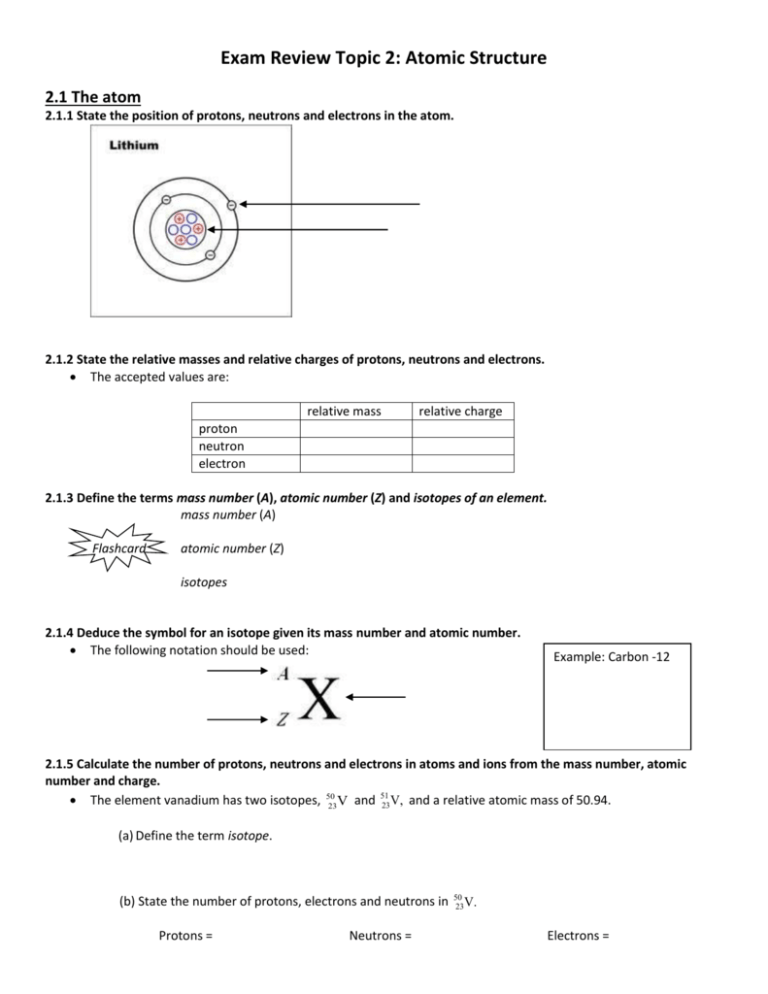Unit 1 Exam Review
advertisement

Exam Review Topic 2: Atomic Structure 2.1 The atom 2.1.1 State the position of protons, neutrons and electrons in the atom. 2.1.2 State the relative masses and relative charges of protons, neutrons and electrons. The accepted values are: relative mass relative charge proton neutron electron 2.1.3 Define the terms mass number (A), atomic number (Z) and isotopes of an element. mass number (A) Flashcard atomic number (Z) isotopes 2.1.4 Deduce the symbol for an isotope given its mass number and atomic number. The following notation should be used: Example: Carbon -12 2.1.5 Calculate the number of protons, neutrons and electrons in atoms and ions from the mass number, atomic number and charge. The element vanadium has two isotopes, 5023V and 51 23 V, and a relative atomic mass of 50.94. (a) Define the term isotope. (b) State the number of protons, electrons and neutrons in Protons = Neutrons = 50 23 V. Electrons = State the number of protons, electrons and neutrons in one Protons = 24 +2 12 Mg Neutrons = ion? Electrons = (b) State and explain which is the more abundant isotope. (d)State the name and the mass number of the isotope relative to which all atomic masses are measured. 2.1.6 Compare the properties of the isotopes of an element. (a) State a physical property that is different for isotopes of an element. (b) Chlorine exists as two isotopes, 35Cl and 37Cl. The relative atomic mass of chlorine is 35.45. Calculate the percentage abundance of each isotope. 2.1.7 Discuss the uses of radioisotopes 3 Examples should include 14C in radiocarbon dating, 60Co in radiotherapy, and 131I and 125I as medical tracers. 2.2 The mass spectrometer 2.2.1 Describe and explain the operation of a mass spectrometer. The following stages of operation should be considered: vaporization ionization acceleration deflection detection o State the names of the other three processes in the order in which they occur in a mass spectrometer. For each of the processes named outline how the process occurs. 2.2.2 Describe how the mass spectrometer may be used to determine relative atomic mass using the 12C scale. 2.2.3 Calculate non-integer relative atomic masses and abundance of isotopes from given data. The relative atomic mass of chlorine is 35.45. Calculate the percentage abundance of the two isotopes of chlorine, 35Cl and 37Cl in a sample of chlorine gas. A certain sample of element Z contains 60% of 69Z and 40% of 71Z. What is the relative atomic mass of element Z in this sample? 2.3 Electron arrangement 2.3.1 Describe the electromagnetic spectrum. Students should be able to identify the ultraviolet, visible and infrared regions, and to describe the variation in wavelength, frequency and energy across the spectrum. 2.3.2 Distinguish between a continuous spectrum and a line spectrum. continuous spectrum: shows emission over a ________________ of wavelengths of electromagnetic radiation line spectrum: only shows emissions at ___________ wavelengths, with no emission at ________________wavelengths. 2.3.3 Explain how the lines in the emission spectrum of hydrogen are related to electron energy levels. Students should be able to draw an energy level diagram, show transitions between different energy levels and recognize that the lines in a line spectrum are directly related to these differences. The energy level diagram An understanding of convergence is expected. Draw convergence here: Series should be considered in the ultraviolet, visible and infrared regions of the spectrum . 2.3.4 Deduce the electron arrangement for atoms and ions up to Z = 20. For example, 2.8.7 or 2,8,7 for Z = 17. Try for the following elements Carbon Potassium Z= Z= Neon Z= EA= EA= EA= HL Material 12.1 Electron Configuration 12.1.1 Explain how evidence from first ionization energies across periods accounts for the existence of main energy levels and sub-levels in atoms 12.1.2 Explain how successive ionization energy data is related to the electron configuration of an atom. 12.1.3 State the relative energies of s, p, d, and f orbitals in a single energy level. 12.1.4 State the maximum number of orbitals in a given energy level. Level N=1 N=2 N=3 N=4 Sub-Level Max Number of electrons in sublevel Max number of electrons in level 12.1.5 Draw the shape of an s orbital and the shapes of the px, py and pz orbitals. 12.1.6 Apply the Aufbau principle, Hund’s rule and the Pauli exclusion principle to write electron configurations for atoms and ions up to Z=54 Define Aufbau’s Principle: (a) Use the Aufbau principle to write the electron configuration of an atom of germanium. ................................................................................................................................... (1) (b) The successive ionization energies of germanium are shown in the following table: Ionization energy / kJ mol–1 (i) 1st 2nd 3rd 4th 5th 760 1540 3300 4390 8950 Identify the sub-level from which the electron is removed when the first ionization energy of germanium is measured. ......................................................................................................................... (1) (ii) Write an equation, including state symbols, for the process occurring when measuring the second ionization energy of germanium. ......................................................................................................................... (1) (iii) Explain why the difference between the 4th and 5th ionization energies is much greater than the difference between any two other successive values. ......................................................................................................................... ......................................................................................................................... ......................................................................................................................... (2) (Total 5 marks) Write the electron configuration for: Al Al+ Al+2 Al+3 Use the periodic table to find the full ground-state electron configuration for the following elements: Cl Ge Nb Sb O2ClTi3+ Zn2+ State the full electron configuration of argon Give formulas of two oppositely charge ions which have the same electron configuration as argon.








